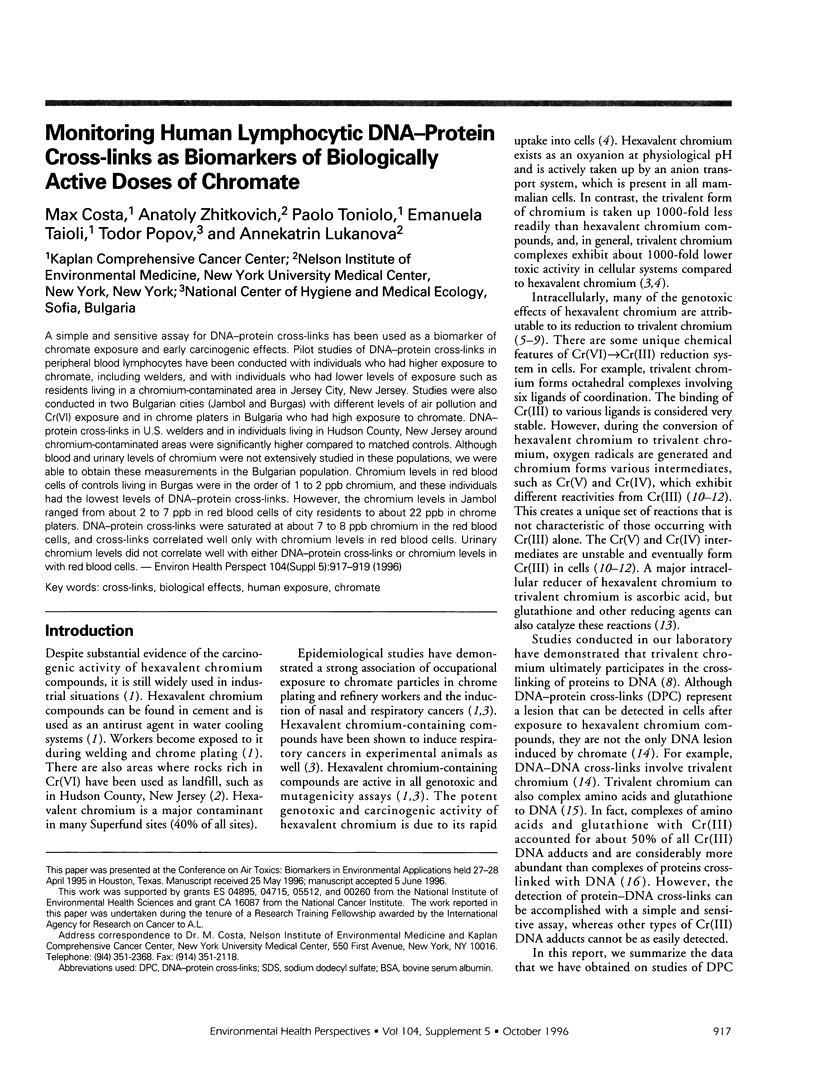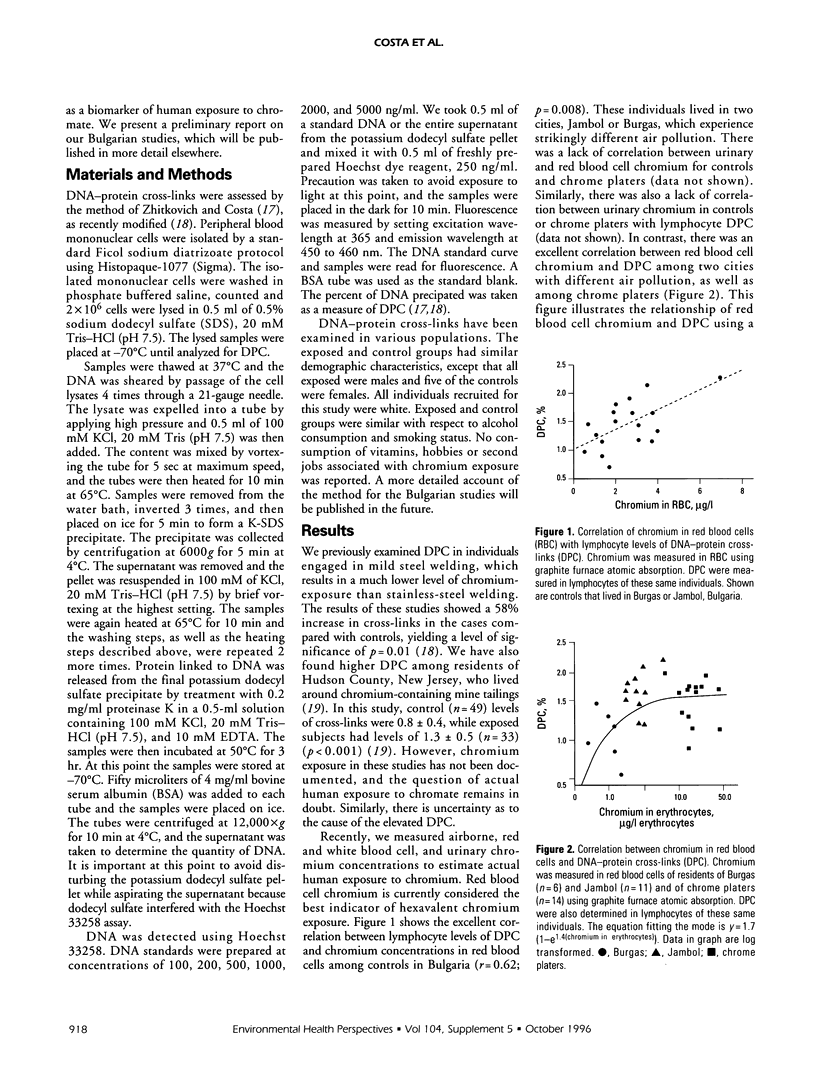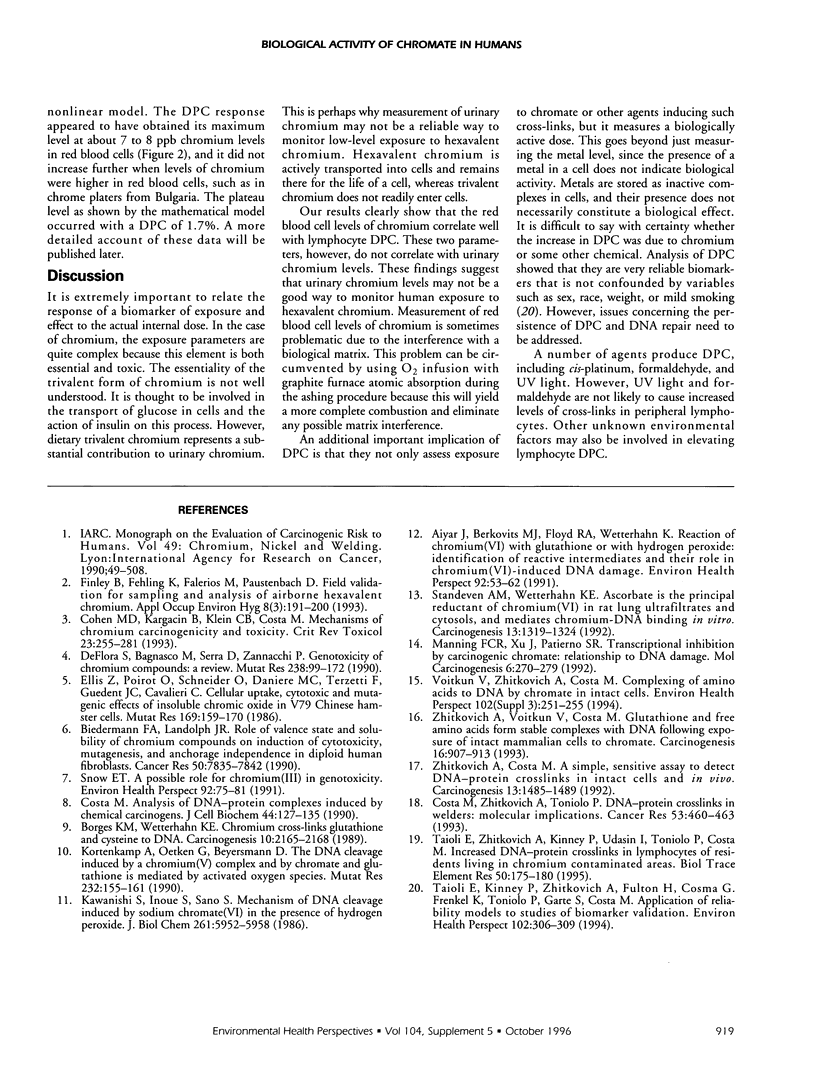Abstract
A simple and sensitive assay for DNA-protein cross-links has been used as a biomarker of chromate exposure and early carcinogenic effects. Pilot studies of DNA-protein cross-links in peripheral blood lymphocytes have been conducted with individuals who had higher exposure to chromate, including welders, and with individuals who had lower levels of exposure such as residents living in a chromium-contaminated area in Jersey City, New Jersey. Studies were also conducted in two Bulgarian cities (Jambol and Burgas) with different levels of air pollution and Cr(VI) exposure and in chrome platers in Bulgaria who had high exposure to chromate. DNA-protein cross-links in U.S. welders and in individuals living in Hudson County, New Jersey around chromium-contaminated areas were significantly higher compared to matched controls. Although blood and urinary levels of chromium were not extensively studied in these populations, we were able to obtain these measurements in the Bulgarian population. Chromium levels in red blood cells of controls living in Burgas were in the order of 1 to 2 ppb chromium, and these individuals had the lowest levels of DNA-protein cross-links. However, the chromium levels in Jambol ranged from about 2 to 7 ppb in red blood cells of city residents to about 22 ppb in chrome platers. DNA-protein cross-links were saturated at about 7 to 8 ppb chromium in the red blood cells, and cross-links correlated well only with chromium levels in red blood cells. Urinary chromium levels did not correlate well with either DNA-protein cross-links or chromium levels in with red blood cells.
Full text
PDF


Selected References
These references are in PubMed. This may not be the complete list of references from this article.
- Aiyar J., Berkovits H. J., Floyd R. A., Wetterhahn K. E. Reaction of chromium(VI) with glutathione or with hydrogen peroxide: identification of reactive intermediates and their role in chromium(VI)-induced DNA damage. Environ Health Perspect. 1991 May;92:53–62. doi: 10.1289/ehp.919253. [DOI] [PMC free article] [PubMed] [Google Scholar]
- Biedermann K. A., Landolph J. R. Role of valence state and solubility of chromium compounds on induction of cytotoxicity, mutagenesis, and anchorage independence in diploid human fibroblasts. Cancer Res. 1990 Dec 15;50(24):7835–7842. [PubMed] [Google Scholar]
- Borges K. M., Wetterhahn K. E. Chromium cross-links glutathione and cysteine to DNA. Carcinogenesis. 1989 Nov;10(11):2165–2168. doi: 10.1093/carcin/10.11.2165. [DOI] [PubMed] [Google Scholar]
- Cohen M. D., Kargacin B., Klein C. B., Costa M. Mechanisms of chromium carcinogenicity and toxicity. Crit Rev Toxicol. 1993;23(3):255–281. doi: 10.3109/10408449309105012. [DOI] [PubMed] [Google Scholar]
- Costa M. Analysis of DNA-protein complexes induced by chemical carcinogens. J Cell Biochem. 1990 Nov;44(3):127–135. doi: 10.1002/jcb.240440302. [DOI] [PubMed] [Google Scholar]
- Costa M., Zhitkovich A., Toniolo P. DNA-protein cross-links in welders: molecular implications. Cancer Res. 1993 Feb 1;53(3):460–463. [PubMed] [Google Scholar]
- De Flora S., Bagnasco M., Serra D., Zanacchi P. Genotoxicity of chromium compounds. A review. Mutat Res. 1990 Mar;238(2):99–172. doi: 10.1016/0165-1110(90)90007-x. [DOI] [PubMed] [Google Scholar]
- Elias Z., Poirot O., Schneider O., Danière M. C., Terzetti F., Guedenet J. C., Cavelier C. Cellular uptake, cytotoxic and mutagenic effects of insoluble chromic oxide in V79 Chinese hamster cells. Mutat Res. 1986 Mar;169(3):159–170. doi: 10.1016/0165-1218(86)90095-9. [DOI] [PubMed] [Google Scholar]
- Kawanishi S., Inoue S., Sano S. Mechanism of DNA cleavage induced by sodium chromate(VI) in the presence of hydrogen peroxide. J Biol Chem. 1986 May 5;261(13):5952–5958. [PubMed] [Google Scholar]
- Kortenkamp A., Oetken G., Beyersmann D. The DNA cleavage induced by a chromium(V) complex and by chromate and glutathione is mediated by activated oxygen species. Mutat Res. 1990 Oct;232(2):155–161. doi: 10.1016/0027-5107(90)90120-s. [DOI] [PubMed] [Google Scholar]
- Manning F. C., Xu J., Patierno S. R. Transcriptional inhibition by carcinogenic chromate: relationship to DNA damage. Mol Carcinog. 1992;6(4):270–279. doi: 10.1002/mc.2940060409. [DOI] [PubMed] [Google Scholar]
- Snow E. T. A possible role for chromium(III) in genotoxicity. Environ Health Perspect. 1991 May;92:75–81. doi: 10.1289/ehp.919275. [DOI] [PMC free article] [PubMed] [Google Scholar]
- Standeven A. M., Wetterhahn K. E. Ascorbate is the principal reductant of chromium(VI) in rat lung ultrafiltrates and cytosols, and mediates chromium-DNA binding in vitro. Carcinogenesis. 1992 Aug;13(8):1319–1324. doi: 10.1093/carcin/13.8.1319. [DOI] [PubMed] [Google Scholar]
- Taioli E., Kinney P., Zhitkovich A., Fulton H., Voitkun V., Cosma G., Frenkel K., Toniolo P., Garte S., Costa M. Application of reliability models to studies of biomarker validation. Environ Health Perspect. 1994 Mar;102(3):306–309. doi: 10.1289/ehp.94102306. [DOI] [PMC free article] [PubMed] [Google Scholar]
- Taioli E., Zhitkovich A., Kinney P., Udasin I., Toniolo P., Costa M. Increased DNA-protein crosslinks in lymphocytes of residents living in chromium-contaminated areas. Biol Trace Elem Res. 1995 Dec;50(3):175–180. doi: 10.1007/BF02785408. [DOI] [PubMed] [Google Scholar]
- Voitkun V., Zhitkovich A., Costa M. Complexing of amino acids to DNA by chromate in intact cells. Environ Health Perspect. 1994 Sep;102 (Suppl 3):251–255. doi: 10.1289/ehp.94102s3251. [DOI] [PMC free article] [PubMed] [Google Scholar]
- Zhitkovich A., Costa M. A simple, sensitive assay to detect DNA-protein crosslinks in intact cells and in vivo. Carcinogenesis. 1992 Aug;13(8):1485–1489. doi: 10.1093/carcin/13.8.1485. [DOI] [PubMed] [Google Scholar]
- Zhitkovich A., Voitkun V., Costa M. Glutathione and free amino acids form stable complexes with DNA following exposure of intact mammalian cells to chromate. Carcinogenesis. 1995 Apr;16(4):907–913. doi: 10.1093/carcin/16.4.907. [DOI] [PubMed] [Google Scholar]


